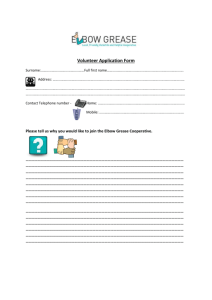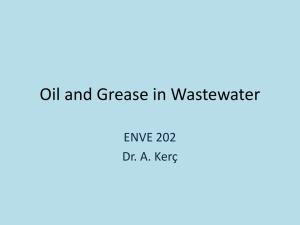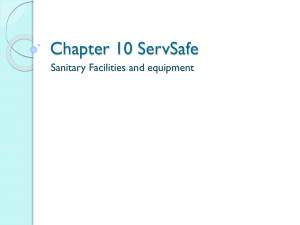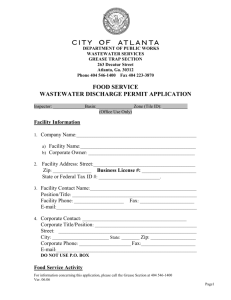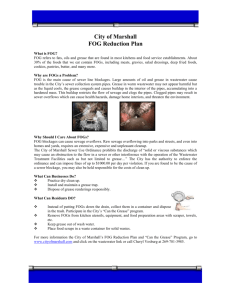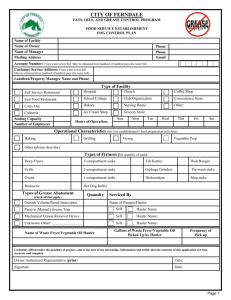MPT Jam- Apply Grease_1_rev_a
advertisement
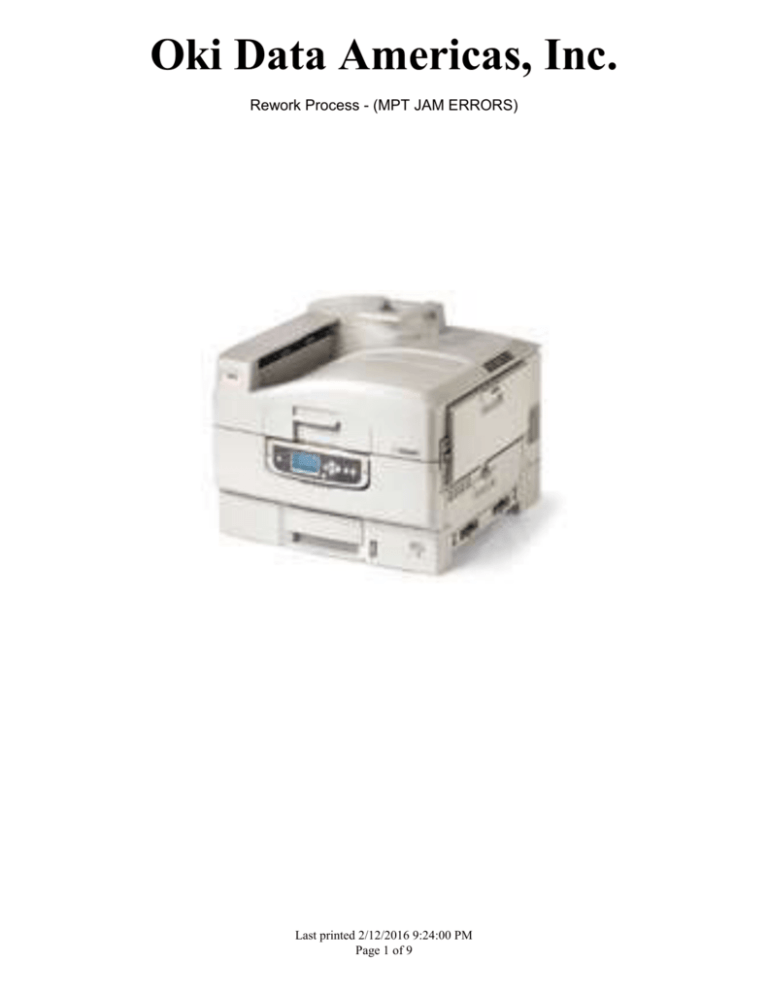
Oki Data Americas, Inc. Rework Process - (MPT JAM ERRORS) Last printed 2/12/2016 9:24:00 PM Page 1 of 9 Oki Data Americas, Inc. PRODUCT: RWK11027 MPT JAM ERRORS- Modify Bearing, Apply Grease, Check Rubber Pads CUT OFF BEARING RIB 1. With printer facing you, open right side access cover as shown. 2. Identify the feed roller, bearing, and e-ring location shown here 3. With sharp utility knife, carefully cut the rib off from the bearing (area to the left of the dotted line). Warning: Be cautious with knife. Do not cut yourself. 4. With magnifying glass, check that the cut is flat. Make sure the cut is straight and clean, see table below. 5. !! Make sure that all loose rib debris is removed from the printer. Check the area and remove as needed. Page 2 of 9 Page 2 of 9 Oki Data Americas, Inc. PRODUCT: RWK11027 MPT JAM ERRORS- Modify Bearing, Apply Grease, Check Rubber Pads APPLY GREASE (Grease is EM30L, see attached MSDS sheet. use protective eyewear and gloves) 6. Apply grease, Class C Amount to the space shown below (e-ring gap). Cover the length of the space. 7. Close access cover. Page 3 of 9 Page 3 of 9 Oki Data Americas, Inc. PRODUCT: RWK11027 MPT JAM ERRORS- Modify Bearing, Apply Grease, Check Rubber Pads CHECK RUBBER GUIDES 8. Open MPT Tray access door half way. 9. Lift upper section shown to expose rubber pads. 10. Identify 2 rubber pad locations. If rubber is off, push it to correct position as shown. Page 4 of 9 Page 4 of 9 Oki Data Americas, Inc. PRODUCT: RWK11027 MPT JAM ERRORS- Modify Bearing, Apply Grease, Check Rubber Pads Page 5 of 9 ************************************************************************************************* MSDS REFERENCE SHEET ************************************************************************************************* DOW CORNING CORPORATION Material Safety Data Sheet Page: 1 of 8 Version: 1.6 Revision Date: 2011/11/07 MOLYKOTE(R) EM-30L GREASE 1. PRODUCT AND COMPANY IDENTIFICATION Dow Corning Corporation South Saginaw Road Midland, Michigan 48686 24 Hour Emergency Telephone: Customer Service: Product Disposal Information: CHEMTREC: (989) 496-5900 (989) 496-6000 (989) 496-6315 (800) 424-9300 MSDS No.: 01843516 Revision Date: 2011/11/07 Generic Description: Inorganic and organic compounds in synthetic oil Physical Form: Grease Color: White Odor: Slight odor NFPA Profile: Health 1 Flammability 1 Instability/Reactivity 0 Note: NFPA = National Fire Protection Association 2. HAZARDS IDENTIFICATION POTENTIAL HEALTH EFFECTS Acute Effects Eye: Direct contact may cause temporary redness and discomfort. Skin: No significant irritation expected from a single short-term exposure. Inhalation: Material is not likely to present an inhalation hazard at ambient conditions. However, if material is heated or high vapor concentration is attained, central nervous system depression may occur, which is characterized by drowsiness, dizziness, confusion or loss of coordination. Oral: Low ingestion hazard in normal use. Prolonged/Repeated Exposure Effects Skin: Repeated or prolonged contact may cause defatting and drying of skin which may result in skin irritation and dermatitis. Inhalation: No known applicable information. Oral: Repeated ingestion or swallowing large amounts may injure internally. Signs and Symptoms of Overexposure No known applicable information. Page 5 of 9 Oki Data Americas, Inc. PRODUCT: RWK11027 MPT JAM ERRORS- Modify Bearing, Apply Grease, Check Rubber Pads Page 6 of 9 DOW CORNING CORPORATION Material Safety Data Sheet Page: 2 of 8 Version: 1.6 Revision Date: 2011/11/07 MOLYKOTE(R) EM-30L GREASE Medical Conditions Aggravated by Exposure No known applicable information. The above listed potential effects of overexposure are based on actual data, results of studies performed upon similar compositions, component data and/or expert review of the product. Please refer to Section 11 for the detailed toxicology information. 3. COMPOSITION/INFORMATION ON INGREDIENTS CAS Number Wt % Component Name 68037-01-4 30.0 - 50.0 Dec-1-ene, homopolymer, hydrogenated The above components are hazardous as defined in 29 CFR 1910.1200. 4. FIRST AID MEASURES Eye: If irritation occurs, flush eye(s) with lukewarm gently flowing water for 5 minutes. Obtain medical attention. Skin: Remove contaminated clothing, shoes and leather goods (e.g. watchbands, belts). Quickly and gently blot or brush away excess chemical. Flush with lukewarm gently flowing water for 15 minutes. If irritation persists, repeat flushing. If irritation persists, obtain medical advice. Inhalation: If symptoms are experienced remove source of contamination or move victim to fresh air. If irritation persists, obtain medical advice. Oral: If irritation or discomfort occur, obtain medical advice. Notes to Physician: Treat according to person's condition and specifics of exposure. 5. FIRE FIGHTING MEASURES Flash Point: Not applicable. Autoignition Temperature: Not determined. Flammability Limits in Air: Not determined. Extinguishing Media: On large fires use dry chemical, foam or water spray. On small fires use carbon dioxide (CO2), dry chemical or water spray. Water can be used to cool fire exposed containers. Fire Fighting Measures: Self-contained breathing apparatus and protective clothing should be worn in fighting large fires involving chemicals. Determine the need to evacuate or isolate the area according to your local emergency plan. Use water spray to keep fire exposed containers cool. Page: 3 of 8 Version: 1.6 Revision Date: 2011/11/07 MOLYKOTE(R) EM-30L GREASE Unusual Fire Hazards: None. 6. ACCIDENTAL RELEASE MEASURES Containment/Clean up: Observe all personal protection equipment recommendations described in Sections 5 and 8. Wipe up or scrape up and contain for salvage or disposal. Clean area as appropriate since spilled materials, even in small quantities, may present a slip hazard. Final cleaning may require use of steam, solvents or detergents. Dispose of saturated absorbant or cleaning materials appropriately, since spontaneous heating may occur. Local, state and federal laws and regulations may apply to releases and disposal of this material, as well as those materials and items employed in the cleanup of releases. You will need to determine which federal, state and local laws and regulations are applicable. Sections 13 and 15 of this MSDS provide information regarding certain federal and state requirements. Note: See Section 8 for Personal Protective Equipment for Spills. Call (989) 496-5900, if additional information is required. 7. HANDLING AND STORAGE Use with adequate ventilation. At temperatures above 482F/250C this material may produce highly toxic gaseous compounds such as hydrogen fluoride and perfluorohydrocarbons. Provide adequate ventilation or use the appropriate respiratory protection if the possibility of exceeding 482F/250C exists. Avoid contamination of tobacco products. Fluoropolymers on tobacco goods may cause adverse health effects by inhalation of the decomposition products. Employees should wash their hands and face before eating, drinking or using tobacco products. Avoid eye contact. Avoid skin contact. Avoid breathing vapor, mist, dust, or fumes. Keep container closed. Do not take internally. Use reasonable care and store away from oxidizing materials. This material in its finely divided form presents an explosion hazard. Follow NFPA 654 (for chemical dusts) or 484 (for metal dusts) as appropriate for managing dust hazards to minimize secondary explosion potential. 8. EXPOSURE CONTROLS / PERSONAL PROTECTION Component Exposure Limits There are no components with workplace exposure limits. Engineering Controls Local Ventilation: Recommended.General Ventilation: Recommended. Personal Protective Equipment for Routine Handling Page 6 of 9 Oki Data Americas, Inc. PRODUCT: RWK11027 MPT JAM ERRORS- Modify Bearing, Apply Grease, Check Rubber Pads Page 7 of 9 DOW CORNING CORPORATION Material Safety Data Sheet Page: 4 of 8 Version: 1.6 Revision Date: 2011/11/07 MOLYKOTE(R) EM-30L GREASE Eyes: Use proper protection - safety glasses as a minimum. Skin: Wash at mealtime and end of shift. Contaminated clothing and shoes should be removed as soon as practical and thoroughly cleaned before reuse. Chemical protective gloves are recommended. Suitable Gloves: Avoid skin contact by implementing good industrial hygiene practices and procedures. Select and use gloves and/or protective clothing to further minimize the potential for skin contact. Consult with your glove and/or personnel protective equipment manufacturer for selection of appropriate compatible materials. Inhalation: Use respiratory protection unless adequate local exhaust ventilation is provided or exposure assessment demonstrates that exposures are within recommended exposure guidelines. IH personnel can assist in judging the adequacy of existing engineering controls. Suitable Respirator: Respiratory protection is not needed under ambient conditions. If vapor is generated when material is heated or handled, the following is advised. General and local exhaust ventilation is recommended to maintain vapor exposures below recommended limits. Where concentrations are above recommended limits or are unknown, appropriate respiratory protection should be worn. Follow OSHA respirator regulations (29 CFR 1910.134) and use NIOSH/MSHA approved respirators. Personal Protective Equipment for Spills Eyes: Use full face respirator. Skin: Wash at mealtime and end of shift. Contaminated clothing and shoes should be removed as soon as practical and thoroughly cleaned before reuse. Chemical protective gloves are recommended. Inhalation/Suitable Respirator: Respiratory protection recommended. Follow OSHA Respirator Regulations (29 CFR 1910.134) and use NIOSH/MHSA approved respirators. Protection provided by air purifying respirators against exposure to any hazardous chemical is limited. Use a positive pressure air supplied respirator if there is any potential for uncontrolled release, exposure levels are unknown, or any other circumstance where air purifying respirators may not provide adequate protection. Precautionary Measures: Avoid eye contact. Avoid skin contact. Avoid breathing vapor, mist, dust, or fumes. Keep container closed. Do not take internally. Use reasonable care. Comments: At temperatures above 482F/250C this material may produce highly toxic gaseous compounds such as hydrogen fluoride and perfluorohydrocarbons. Provide adequate ventilation or use the appropriate respiratory protection if the possibility of exceeding 482F/250C exists. Avoid contamination of tobacco products. Fluoropolymers on tobacco goods may cause adverse health effects by inhalation of the decomposition products. Employees should wash their hands and face before eating, drinking or using tobacco products. Page 7 of 9 Oki Data Americas, Inc. PRODUCT: RWK11027 MPT JAM ERRORS- Modify Bearing, Apply Grease, Check Rubber Pads Page 8 of 9 DOW CORNING CORPORATION Material Safety Data Sheet Page: 5 of 8Version: 1.6 Revision Date: 2011/11/07 MOLYKOTE(R) EM-30L GREASE Note: These precautions are for room temperature handling. Use at elevated temperature or aerosol/spray applications may require added precautions. 9. PHYSICAL AND CHEMICAL PROPERTIES Physical Form: Grease Color: White Odor: Slight odor Specific Gravity @ 25°C: 0.9 Viscosity: Not determined. Freezing/Melting Point: Not determined. Boiling Point: Not determined. Vapor Pressure @ 25°C: Not determined. Vapor Density: Not determined. Solubility in Water: Not determined. pH: Not determined. Volatile Content: Not determined. Flash Point: Not applicable. Autoignition Temperature: Not determined. Flammability Limits in Air: Not determined. Note: The above information is not intended for use in preparing product specifications. Contact Dow Corning before writing specifications. 10. STABILITY AND REACTIVITY Chemical Stability: Stable. Hazardous Polymerization: Hazardous polymerization will not occur. Conditions to Avoid: None. Materials to Avoid: Oxidizing material can cause a reaction. Hazardous Decomposition Products Thermal breakdown of this product during fire or very high heat conditions may evolve the following decomposition products: Carbon oxides and traces of incompletely burned carbon compounds. Metal oxides. Nitrogen oxides. Fluorine compounds. Phosphorous oxides. Formaldehyde. 11. TOXICOLOGICAL INFORMATION Component Toxicology Information Inhalation of fumes from fire decomposition of polytetrafluoroethylene (Teflon) is known to cause polymer fume fever. Page: 6 of 8Version: 1.6 Revision Date: 2011/11/07 Special Hazard Information on Components No known applicable information. 12. ECOLOGICAL INFORMATION Environmental Fate and Distribution Complete information is not yet available. Environmental Effects Complete information is not yet available. Fate and Effects in Waste Water Treatment Plants Complete information is not yet available. Ecotoxicity Classification Criteria Hazard Parameters (LC50 or EC50) High Medium Low Acute Aquatic Toxicity (mg/L) <=1 >1 and <=100 >100 Acute Terrestrial Toxicity <=100 >100 and <= 2000 >2000 This table is adapted from "Environmental Toxicology and Risk Assessment", ASTM STP 1179, p.34, 1993. This table can be used to classify the ecotoxicity of this product when ecotoxicity data is listed above. Please read the other information presented in the section concerning the overall ecological safety of this material. 13. DISPOSAL CONSIDERATIONS RCRA Hazard Class (40 CFR 261) When a decision is made to discard this material, as received, is it classified as a hazardous waste? No State or local laws may impose additional regulatory requirements regarding disposal. Call (989) 496-6315, if additional information is required. 14. TRANSPORT INFORMATION DOT Road Shipment Information (49 CFR 172.101) Not subject to DOT. Ocean Shipment (IMDG) Not subject to IMDG code. Air Shipment (IATA) Page 8 of 9 Oki Data Americas, Inc. PRODUCT: RWK11027 MPT JAM ERRORS- Modify Bearing, Apply Grease, Check Rubber Pads Page 9 of 9 DOW CORNING CORPORATION Material Safety Data Sheet Page: 7 of 8 Version: 1.6 Revision Date: 2011/11/07 MOLYKOTE(R) EM-30L GREASE Not subject to IATA regulations. Call Dow Corning Transportation, (989) 496-8577, if additional information is required. 15. REGULATORY INFORMATION Contents of this MSDS comply with the OSHA Hazard Communication Standard 29 CFR 1910.1200. TSCA Status: All chemical substances in this material are included on or exempted from listing on the TSCA Inventory of Chemical Substances. EPA SARA Title III Chemical Listings Section 302 Extremely Hazardous Substances (40 CFR 355): None. Section 304 CERCLA Hazardous Substances (40 CFR 302): None. Section 311/312 Hazard Class (40 CFR 370): Acute: No Chronic: No Fire: No Pressure: No Reactive: No Section 313 Toxic Chemicals (40 CFR 372): None present or none present in regulated quantities. Note: Chemicals are listed under the 313 Toxic Chemicals section only if they meet or exceed a reporting threshold. Supplemental State Compliance Information California Warning: This product contains the following chemical(s) listed by the State of California under the Safe Drinking Water and Toxic Enforcement Act of 1986 (Proposition 65) as being known to cause cancer, birth defects or other reproductive harm. None known. Massachusetts CAS Number Wt % Component Name Page: 8 of 8 Version: 1.6 Revision Date: 2011/11/07 7620-77-1 7.0 - 13.0 12-Hydroxy lithium stearate New Jersey CAS Number Wt % Component Name 151006-60-9 40.0 - 60.0 1-Dodecene, polymer with 1-decene, hydrogenated 68037-01-4 30.0 - 50.0 Dec-1-ene, homopolymer, hydrogenated 7620-77-1 7.0 - 13.0 12-Hydroxy lithium stearate 37640-57-6 5.0 - 10.0 Melamine cyanurate 9002-84-0 3.0 - 7.0 Polytetrafluoroethylene Pennsylvania CAS Number Wt % Component Name 151006-60-9 40.0 - 60.0 1-Dodecene, polymer with 1-decene, hydrogenated 68037-01-4 30.0 - 50.0 Dec-1-ene, homopolymer, hydrogenated 7620-77-1 7.0 - 13.0 12-Hydroxy lithium stearate 37640-57-6 5.0 - 10.0 Melamine cyanurate 9002-84-0 3.0 - 7.0 Polytetrafluoroethylene 16. OTHER INFORMATION Prepared by: Dow Corning Corporation These data are offered in good faith as typical values and not as product specifications. No warranty, either expressed or implied, is hereby made. The recommended industrial hygiene and safe handling procedures are believed to be generally applicable. However, each user should review these recommendations in the specific context of the intended use and determine whether they are appropriate. (R) indicates Registered Trademark Page 9 of 9
